
The Third Paradise
Story by Alex Crevar | Photos by Paolo Ciaberta
On the penultimate day of a weeklong journey through the middle of southern Italy’s Calabria Region, our course tilted up and left civilization behind. This wasn’t unusual. The undulating bicycle route we followed,
the 338-mile (545-kilometer) Ciclovia Parchi Calabria, was designed to guide cyclists along the tranquil, often-carless, sometimes-mountainous roads connecting the peninsular region’s remote, unindustrialized, and underappreciated interior. For hours at a time — rolling south and lengthwise across Calabria — our only companions were shepherds summoning flocks, ancient beech trees, and 120-foot Bosnian pines.
Still, as we crested this summit, something felt different — more serene. The light and air changed, becoming brighter and even more pure. Pedaling up and over, the reason became obvious: from this ridgeline atop the Calabrian Peninsula, both the Tyrrhenian Sea to the west and Ionian Sea to the east came into view, filling the panorama with a rare joint appearance.
I closed my eyes. For that rarest of moments, the world stopped. My breath merged with sea breezes cradling me from all directions. Opening my eyes, I hopped back on the saddle, began to descend, and thought back to the beginning of this journey. We’d been riding for five days. It felt like a lifetime.
It was mid-October when I flew to Reggio Calabria, the city at the southernmost end of Italy’s boot toe, to begin cycling the Ciclovia Parchi Calabria (CPC), or less lyrically in English: the Calabria Parks Cycle Route. In the airport, with Sicily silhouetted two miles away across the Messina Strait, I met up with my riding companion for the week, Torino-based photographer Paolo Ciaberta. We then collected, unboxed, and assembled our gravel bicycles, reconfigured bike packs, and took a three-hour car transfer to the northern edge of Calabria — among Italy’s least visited regions. From there, we would pedal back along Italy’s Apennine Mountains to this southern tip.
The CPC promised to be more than merely a connection from A to B along an overlooked region’s spine. As the name implies, we would cross multiple parks, four to be exact (from north to south): Pollino National Park, Sila National Park, Serre Regional Natural Park, and Aspromonte National Park. This meant we’d be rolling through some of Europe’s most stunning and protected landscapes.
A collaboration between two parks, which are often run with competitive and territorial zeal, is rare. A partnership between four major parks is unheard of and akin to Coke, Pepsi, RC Cola, and Yoo-Hoo working together on a marketing campaign. I knew, however, the parks involved were serious about encouraging travelers to explore beyond the region’s coastline and discover the Calabrian interior’s culture and singular beauty. (…)

At dinner that night in the town of Laino Borgo, the start of our opening stage, we spread the CPC’s map across a table in the Palia’s Hotel restaurant. We were inside the boundaries of Pollino National Park, the first park we’d visit and Italy’s largest. Within the 750-square-mile Pollino, which extends along the instep of Italy’s boot, there are multiple 7,000-foot summits, a primeval forest, wolves, a UNESCO Global Geopark, and thousand-year-old trees.
Paolo, who had ridden the route before, pointed to the red line wiggling down the map. He explained that the CPC is perfect for cycling because most cars avoid its quiet backroads in favor of the highway closer to the coast. Our plan was to ride around 50 miles per day with approximately 3,000 feet of daily elevation gain.
During breaks in our strategy session, the hotel’s owner and waiter, Roberto, brought out dishes as quickly as his mother could prepare them in the kitchen. “You have to try this,” he’d say with each new concoction as we pushed notebooks, camera lenses, and GPS devices out of the way.
A bottle of local red wine accompanied bruschetta with fresh tomatoes. Then came the antipasto course: pancetta, grilled sheep cheese, cow cheese, mozzarella, and bowls of pickled eggplant, mushrooms, and garlic. When he placed gnocchi with sausage and Calabrian chile sauce in front of us, Roberto hovered until my first forkful. “Is it too picante?” he asked. “The further south you go, the more picante it gets.”
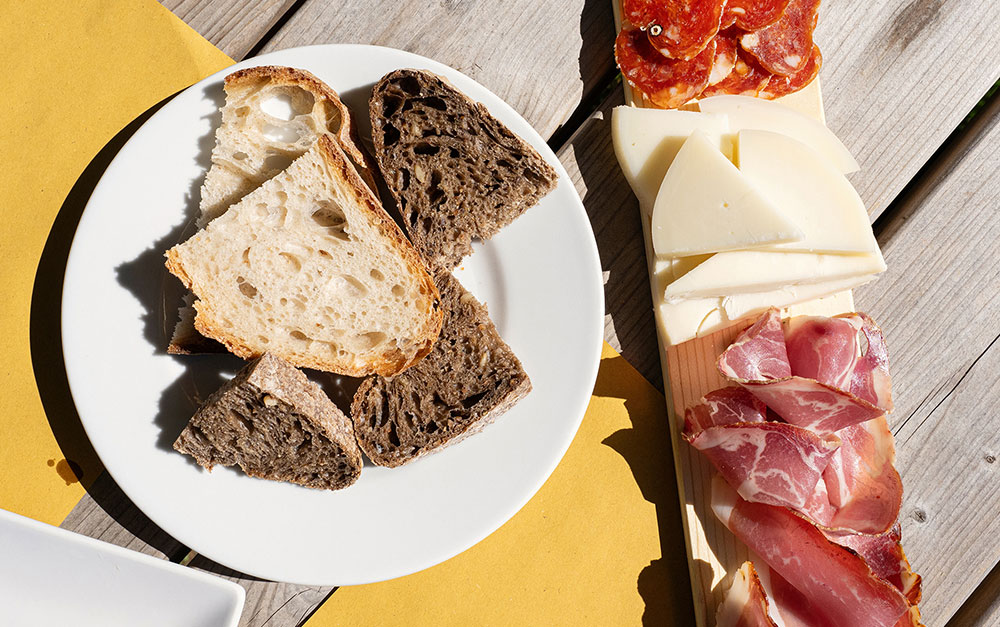
The next morning — after fried eggs, prosciutto, fresh bread, and cookies (in our jersey pockets for safekeeping) — we set off into a thick fog. The route descended into a canyon before crossing the Lao River. The sun broke through the low-hanging mist as we ascended alongside the remains of the Laino Castle, built on a bluff by the Lombards for defense against the Byzantine Empire.
The steady climb continued to the town of Mormanno, where we took a break on a café terrace with views of the valley below and falcons floating on thermal gusts above. We ordered espressos and the town’s signature jam-filled, biscuit-like pastries called bocconotti.
About six miles later, our progressive lunch continued at a spot called Catasta, Pollino National Park’s all-in-one com-munity clubhouse. Inside the building — designed to look like a stack, or Catasta, of logs — there was an education center, a restaurant, and a bottega selling local specialties like wine, honey, and cheese. We grabbed a picnic table outside among families and cyclists relaxing in lounge chairs surrounded by autumnal trees heavy with red, orange, and yellow leaves.
We ordered pints of a local IPA called Honey Monkey and crispy-fried chiles; the spicy scarlet peppers glistened in the sunshine. (…)
Our day ended in Morano Calabro, where terracotta-roofed buildings rose to the town’s pinnacle and gathered around the ruins of a Roman-era fortress. We sat with Nicola Bloise, who has been slowly renovating abandoned dwellings in the ancient hilltop center. Over the years, Bloise has opened 25 of the repurposed houses as travelers’ accommodations — each decorated with artwork from house-hold items (some centuries old) people have discarded over the decades. (…)
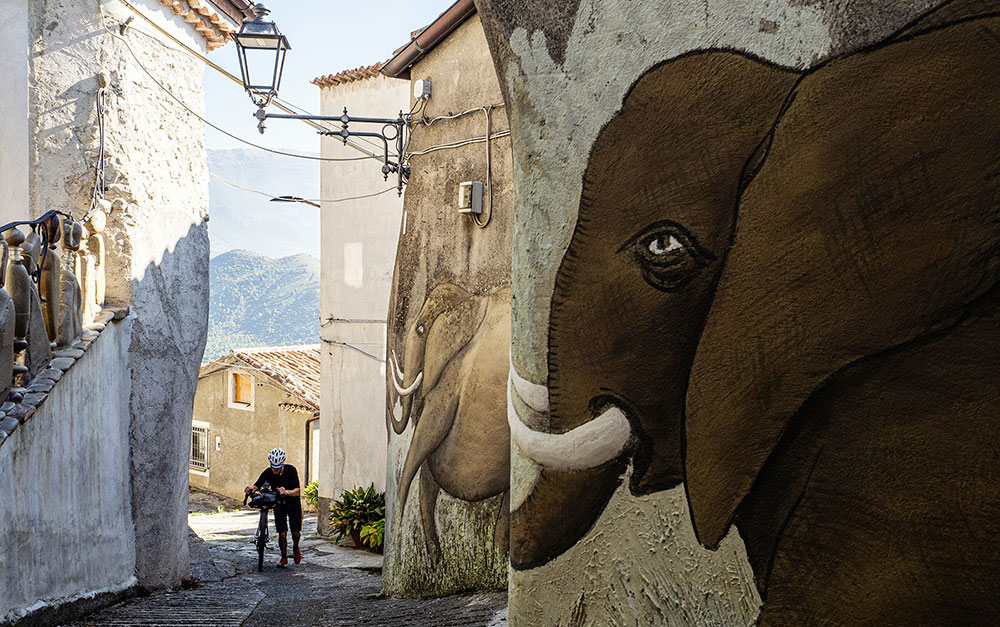
The CPC continued along Pollino’s southeastern boundary, climbing and descending through the town of Castrovillari and the villages of San Basile, Saracena, Firmo, and Lungro. Recently gathered chestnuts were spread out on drying tarps in front of houses along the narrow streets. Handwritten signs advertised homemade, sweet Moscato wine.
We made a big push up to the perched town of Acquaformosa. One of several Calabrian settlements boasting ethnic minority enclaves, the Arbëresh (Albanian) community traces its roots back to families who migrated here five centuries ago to flee the Ottoman Empire spreading across the Balkan Peninsula. Before leaving Pollino for the route’s second park, we stopped in Acquaformosa’s main square for a drink. When the ice-cold beers arrived, a group of workmen in dusty jumpsuits raised their bottles in approval for our vehicles of choice.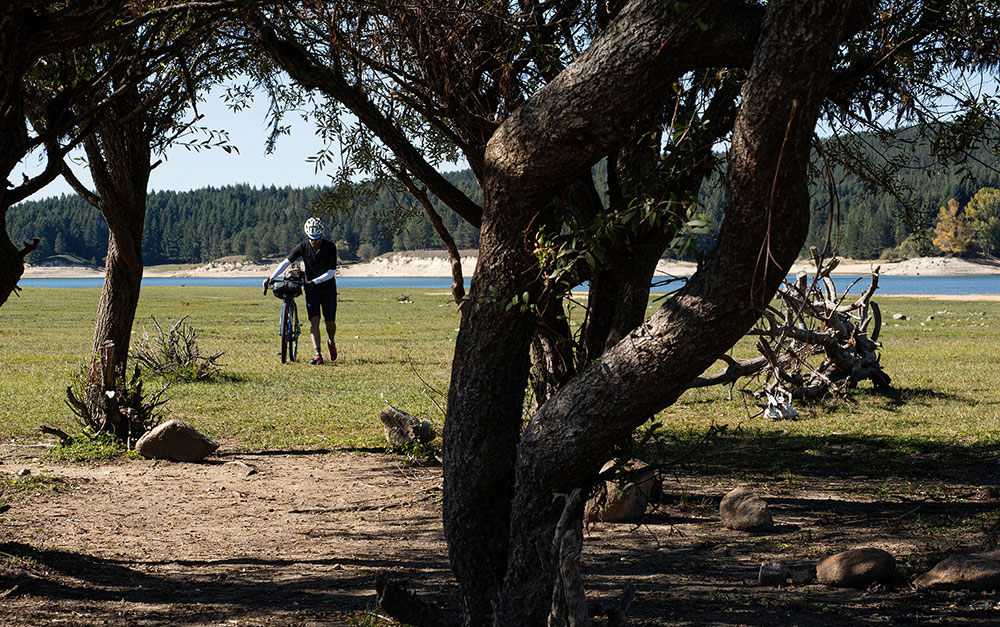
Soon after entering the 285-square-mile Sila National Park, which spreads across Europe’s largest plateau encompassing 19 municipalities, we headed to the day’s destination, Bio Sila: a farm, restaurant, and hotel. We toured the family-run operation, where cattle, sheep, and goats produce over three tons of milk per day — for cheese, ice cream, and yogurt — without pesticides or chemicals. That all-natural process is also used for vegetables grown across the 500-acre expanse.
Soon it was time for dinner. We sat in Bio Sila’s dining room with Giacinto Le Pera, the curator of Calabria’s Siluna Fest, an annual gathering of art lovers, travelers, cyclists, musicians, and stargazers. No sooner had Le Pera begun to explain that the summer festival was inspired by the “Third Paradise” (Terzo Paradiso) concept in which nature (the first paradise) merges with technology (the second paradise) to create a balance (the third paradise), then our own version of heaven appeared from the kitchen. A cutting board overflowing with cow, sheep, and goat cheeses was followed by another with varieties of pork sausage. (…)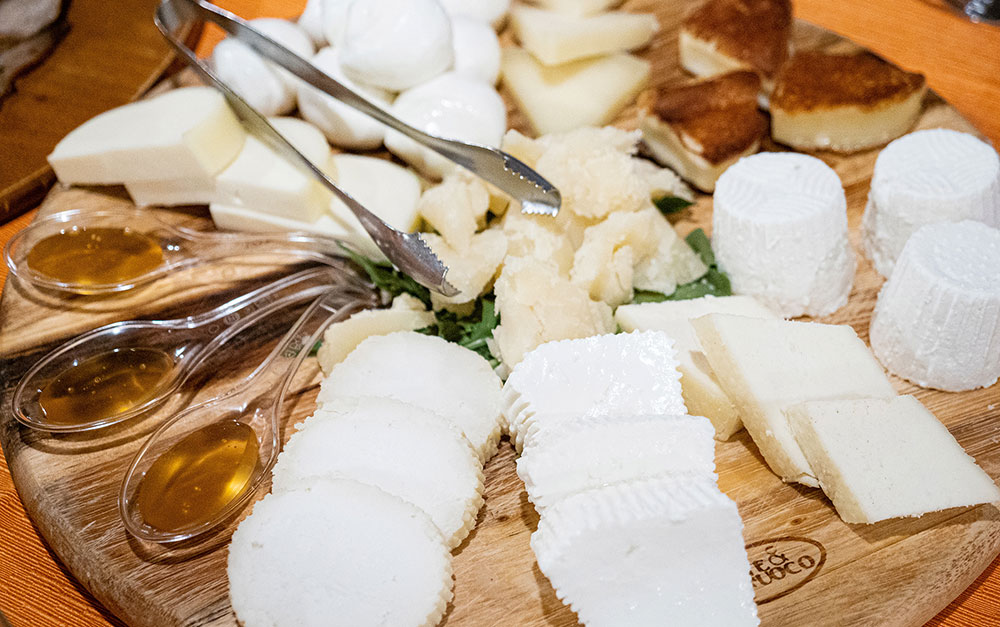
On some expeditions, gourmands must plan carefully to ensure culinary satisfaction. The Ciclovia Parchi Calabria is no such expedition. We rode for two days through the heart of Sila National Park, and in turn through the heart of Calabria. At every stop without fail, exquisitely crafted “fuel” found me in moments of need.
At the Sila Visitor Center next to Lake Cecita, we ate sweet pitta ’mpigliata (swirled pastry filled with honey, raisins, and walnuts). A few miles down the road, at San Lorenzo si Alberga, a hotel in Camigliatello Silano, we dined on potatoes with porcini mushrooms and truffles, chicken and pumpkin risotto, and chicory pork ribs. Not to be outdone, at the Parco Hotel Granaro, a few miles from Sila’s southern boundary, red wine accompanied eggplant ravioli and veal nestled in arugula.
Before leaving the national park, we took a walk with Parco Hotel Granaro’s owner, Mario Talarico, through the prop-erty’s outdoor museum, MABOS (Museo d’Arte del Bosco della Sila), to see its forest full of contemporary sculptures and installations. “There is no tourism without culture,” Mario told us. “Just like this part of Calabria between the seas, this place was born to bring beauty. There is no industry here — just natural ingredients and Europe’s cleanest air.”
By the time we left Sila National Park, it seemed likely I’d gained weight — even with full days in the saddle. At the very least, I am forever spoiled. My monkey diet of bananas and peanuts will never again suffice.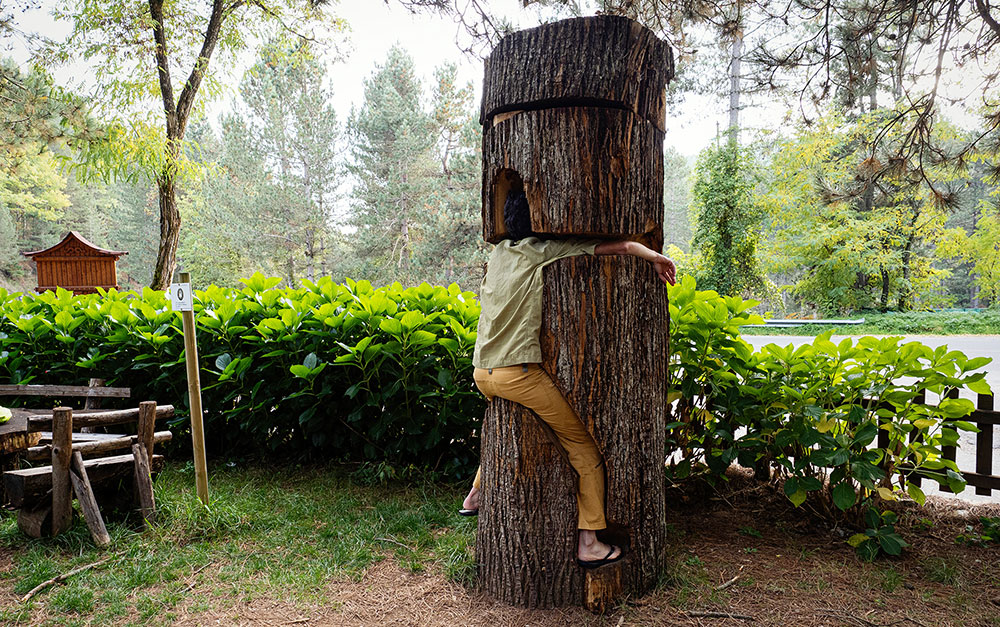
The stretch after Sila kicked and relented and kicked again as we paced ourselves through a series of sharp, persnickety ascents. About three-quarters of the way down the CPC, south of Calabria’s isthmus, we closed the gap and entered the trail’s smallest protected area, the 70-square-mile Serre Regional Natural Park.
The regional park balances raw nature with an anthropological tilt. It felt exploding with life both despite and because
of its small size. Between stands of firs, larch pines, and chestnut trees, we glided through several of the park’s 26 towns, including Serra San Bruno, where the sprawling Carthusian Monastery has been attracting visitors and pilgrims to the mountains since its establishment in the eleventh century.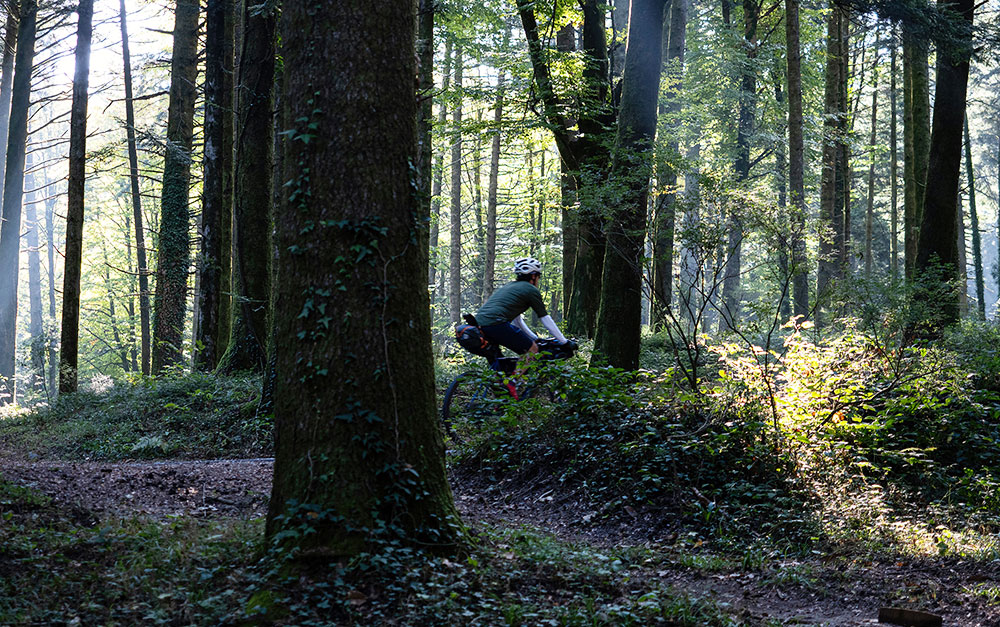
Our persistent climbing paid off as we reached and maintained an elevation of around 3,500 feet. We pedaled along a ridgeline in the clouds. Then, riding out of Serre Regional Park across the dream-like point where both the Tyrrhenian and Ionian Seas came into view, the CPC dove only to tilt up again when we passed into Aspromonte National Park.
Almost immediately after entering the CPC’s final park, we were alone. Though Calabria and the CPC were often remote, the 250-square-mile Aspromonte — stuffed with peaks, dense forests, lakes, and streams — was secluded. No cars,
no cyclists, no people … just a deliciously empty road spiraling around mountains.
When the sun, temperature, and eve-ning dew began to fall, my pedals found rhythmic accord with heart and mind. I tacked back and forth up a string of just-one-more hilltops. We then put our gourmet fuel to work, spinning up to 4,200 feet to our last night’s lodging on the CPC. We stopped at Rifugio Il Biancospino, a family-run mountain hut midway across Aspromonte. (…)
Our final dinner was a cornucopia of greatest hits from Calabria’s Apennine Mountains. The aroma from hearty pasta fagioli mixed with plates of sautéed chanterelle mushrooms, grilled sausages, roasted potatoes, pureed eggplant and tomatoes, and dried chiles to augment all the above. After, we pushed back our chairs and sipped from glasses of amaro, an herbal liqueur, and shelled sweet chestnuts for dessert.
The next morning — following a break-fast of just-made warm bread, butter, and wildberry jam — we mounted our bikes for one last stage. Low-hanging clouds escorted us to the edge of Aspromonte National Park. The sky then opened; the sea became the new horizon. With Sicily’s Mount Etna silhouetted in the distance, we plunged from 4,500 feet to zero in what seemed like an instant.
As Reggio Calabria grew larger and larger, my feelings mixed a sense of accomplishment with homecoming and the reluctance of waking from a dream I inherently knew was too good to be true. Reality, it seemed, had found me again; there were airplanes to catch and deadlines to meet. Still, as I made it to the hotel, where I would re-box my bike and reverse the process from one week ago, I knew I had — even if just for that rarest of moments — found third paradise. 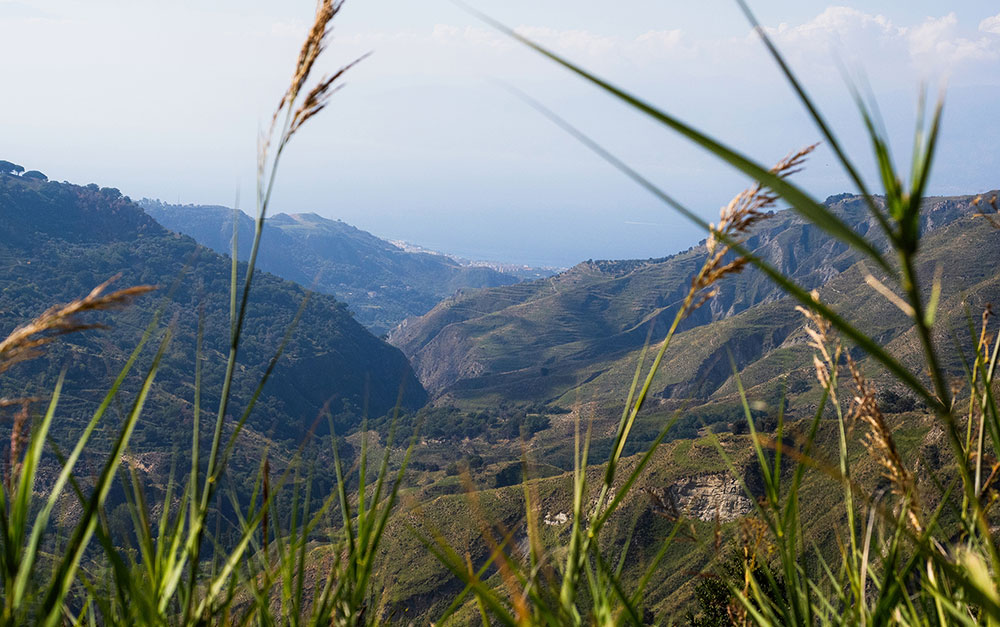
Alex Crevar è un giornalista, redattore e consulente che si dedica al turismo responsabile. Dalla fine degli anni Novanta ha lavorato nei Balcani e ha scritto per molte testate internazionali, tra cui New York Times, National Geographic, Outside, Lonely Planet, Adventure Cyclist, Washington Post, Paste e Bicycling.
The full text was published in 'Adventure Cyclist' [May-June 2023].




